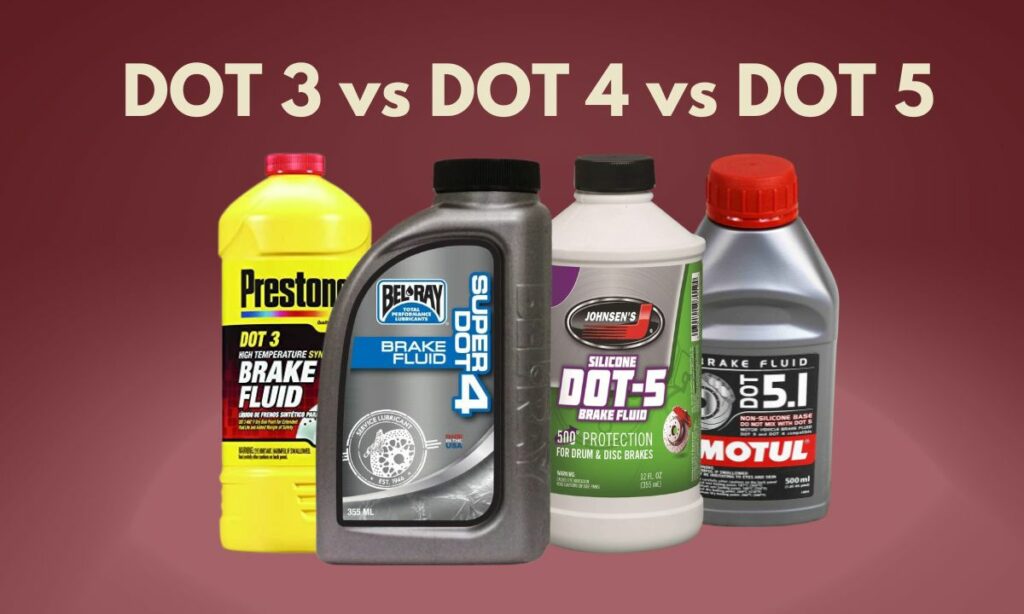The brake fluid you use in your motorcycle should ideally be – non-compressible, have low viscosity, good lubricant properties, high corrosion resistance, and high boiling point.
To make the choice easier, brake fluids are classified into categories: DOT 3, DOT 4, DOT5, and DOT 5.1.
Each brake fluid with its own characteristics.
Put simply:
DOT 3, DOT 4, DOT 5, and DOT 5.1 are brake fluids named according to their boiling points – with DOT 3 having the lowest boiling points and DOT 5.1 having the highest boiling points among these fluids.
The higher the boiling point, the higher the heat the brake fluid can withstand.
While DOT 3, DOT4, and DOT 5.1 are glycol-based brake fluids, DOT 5 is a silicon-based brake fluid.
Despite all these choices available, their applications are quite narrow focused.
DOT 4 is the most popular brake fluid used in motorcycles and other vehicles. Other brake fluids are not really that popular.
As for why is that and what each of these brake fluid characteristics are – lets dive in detail.
DOT 3
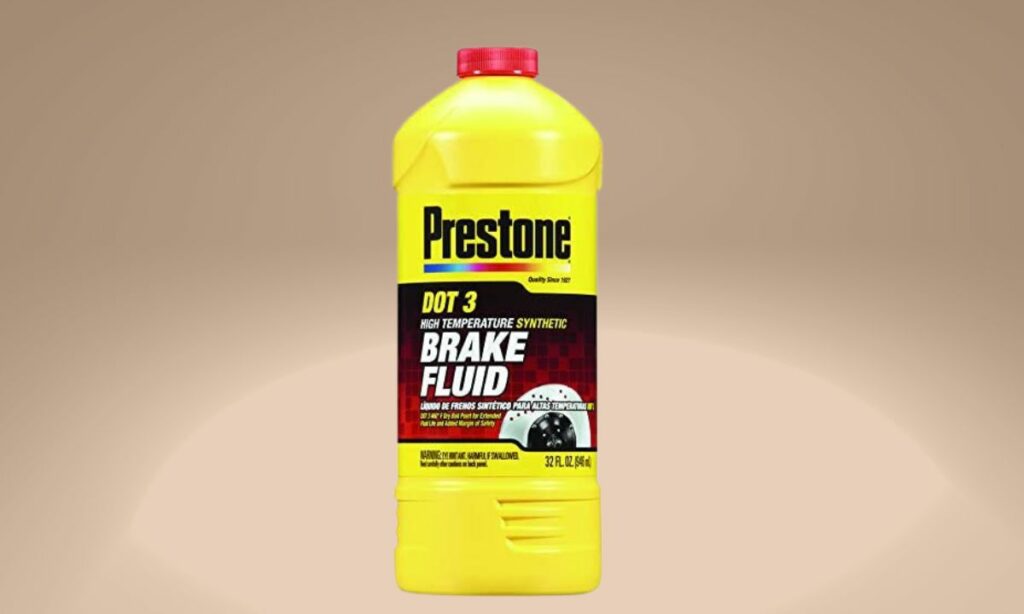
DOT 3 is an outdated brake fluid.
You will rarely find DOT 3 used in any application nowadays.
DOT 3 is a glycol-based brake fluid. The brake fluid’s key ingredient is glycol-ethers.
Glycol-based brake fluids are hygroscopic. Meaning – they absorb moisture and water from the atmosphere.
Since DOT 3 is glycol based, it absorbs moisture easily as well. As a result, DOT 3 brake fluid accumulates around 3% of water in it in a year.
Moisture content is not desirable in brake fluid.
Water in the brake fluid lowers its boiling point. That’s why it is essential to replace the brake fluid regularly. Once every 2 years is the norm to change the brake fluid.
In case you stay in a humid environment, you have it replace the brake fluid earlier than that.
Speaking of boiling points, DOT 3 has the lowest boiling points among other brake fluids.
Here are its boiling points:
- DOT 3 dry boiling point: 401o F / 205o C
- DOT 3 wet boiling point: 284o F / 140o C
As for what dry and wet boiling points are:
A dry boiling point refers to the boiling point where the brake fluid contains no water.
A wet boiling point refers to the boiling point measured when the brake fluid contains 3.7% of water content.
Pros and Cons
Pros:
- DOT 3 brake fluid is cheap and available at low prices
Cons:
- Outdated brake fluid
- Has the lowest boiling point among all the other brake fluids
- Low durability
DOT 4
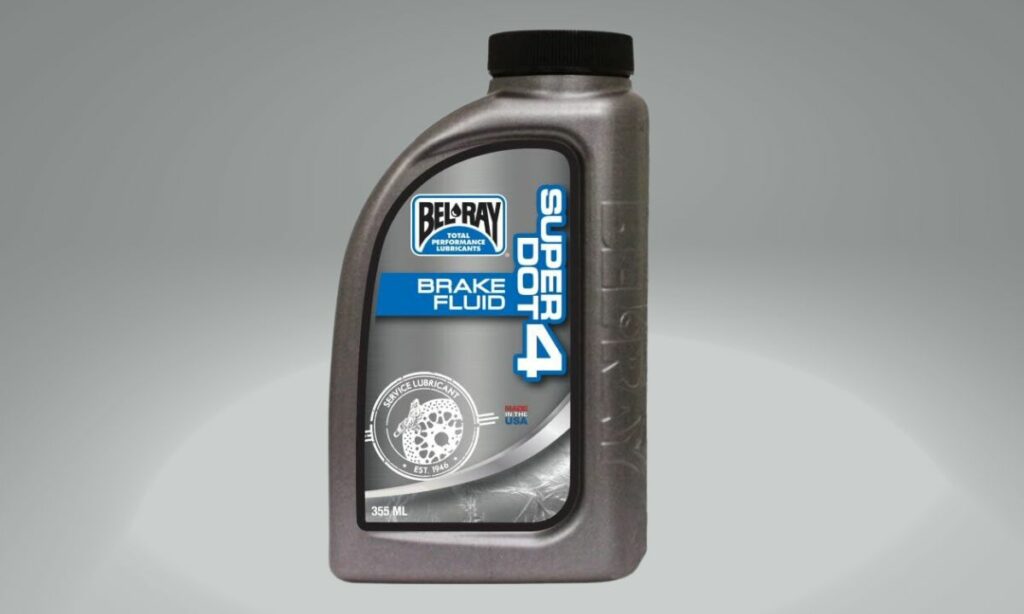
DOT 4 is the popular brake fluid used in motorcycles.
Again, DOT 4 is a glycol-based brake fluid. It absorbs moisture easily. And hence, a DOT 4 brake fluid must be replaced every 2 years.
Here are the DOT 4 boiling points:
- DOT 4 dry boiling point: 446o F / 230o C
- DOT 4 wet boiling point: 311o F / 155o C
As you can observe, DOT 4 has higher boiling points than that of DOT 3.
Unsurprisingly, a DOT 4 brake fluid lasts longer and has better characteristics than a DOT 3 brake fluid.
Once DOT 4 got popularised in automobiles, DOT 3 started losing its relevancy and is rarely used in today’s times now.
Although DOT 5.1 has a better lifespan and is compatible with motorcycles, most motorcycle braking systems are designed for DOT 4.
As a result, DOT 4 is the go-to brake fluid for almost all motorcycles today.
It helps that DOT 4 is compatible with motorcycle braking systems, especially with ABS (anti-lock braking system).
Pros and Cons
Pros:
- Most compatible brake fluid for motorcycles
- Higher boiling points and better lifespan than DOT 3
- Affordable and low cost
Cons:
- Hygroscopic – absorbs moisture easily
- Still, lower boiling points and lifespan when compared to DOT 5 and DOT 5.1
DOT 5
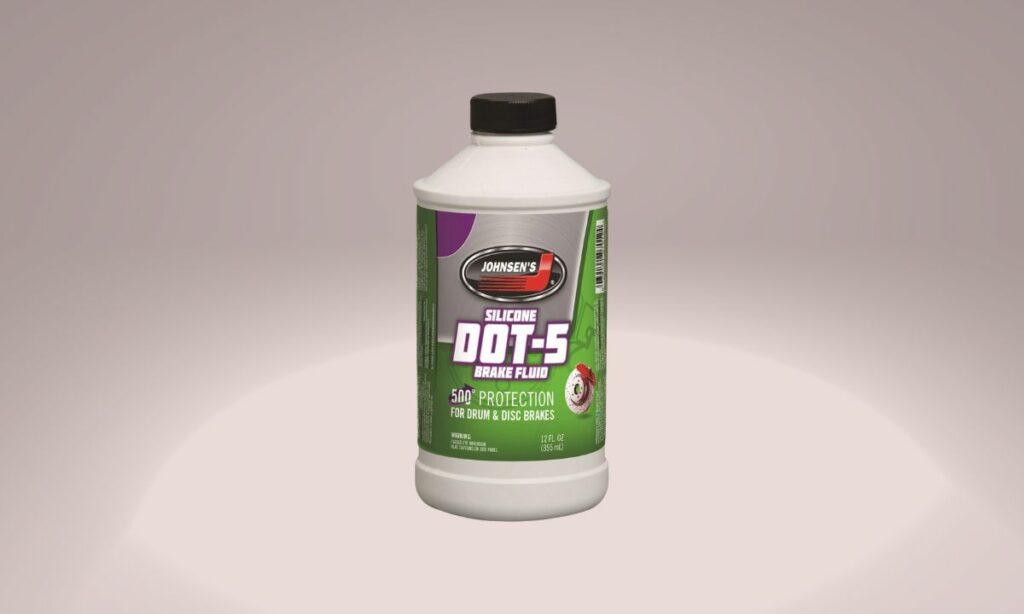
DOT 5 brake fluid is completely different from DOT 3, DOT 4, and even DOT 5.1.
The main reason?
DOT 5 is a silicon-based brake fluid.
Whereas the other brake fluids – DOT 3, DOT4, and yes even DOT 5 are glycol-based brake fluids.
This sets DOT 5 apart from these other brake fluids in almost all characteristics.
What are those?
Let’s start with hygroscopic properties.
DOT 5 brake fluid is hydrophobic. And does not absorb water easily.
This is a great advantage.
One of the main reasons to replace brake fluid regularly is because of its water absorption.
Since DOT 5 does not absorb water easily, you no longer have to change the brake fluid every 2 years.
Next, the boiling points of DOT 5 are higher than DOT 3 and DOT 4.
Here are its boiling points:
- DOT 5 dry boiling point: 500o F / 260o C
- DOT 5 wet boiling point: 356o F / 180o C
The higher the boiling point, the higher the heat the brake fluid can withstand.
The wet boiling point for DOT 5 is more theoretical than actual. DOT 5 is hydrophobic and does not absorb moisture/water. And hence, the wet boiling point provided above is for reference only.
Another advantage of silicon-based brake fluid, which DOT 5 is, is they are harmless to paint.
Glycol-based brake fluids damage painted surfaces. DOT 5 is again better in this aspect.
But it’s not flowers and roses though.
DOT 5 is expensive.
DOT 5 usually costs 4X times the DOT 3 price. That’s quite a costly fluid there.
And there is one more problem. A big one.
Despite such better qualities, DOT 5 is not the preferred brake fluid in most applications.
Most motorcycles still use DOT 4. Not DOT 5.
Why is that though?
DOT 5 brake fluid’s compressibility and viscosity are unsuitable for motorcycles. The fluid’s characteristics are not suitable for smooth riding, especially if the motorcycle has ABS.
Having said that, few motorcycles use or have used DOT 5 in the past. But with the ABS not working well with DOT 5, almost all vehicles use DOT 4 nowadays.
But DOT 5 has its uses.
DOT 5 is mostly used in military equipment. The long life and durability of DOT 5 suit these equipment pieces since these applications sit and stay idle for years at a stretch.
Pros and Cons
Pros:
- Do not absorb moisture
- Higher boiling point
- Harmless to painted surfaces
Cons:
- Expensive
- Not suitable for motorcycles and other vehicles
- Limited application
DOT 5.1
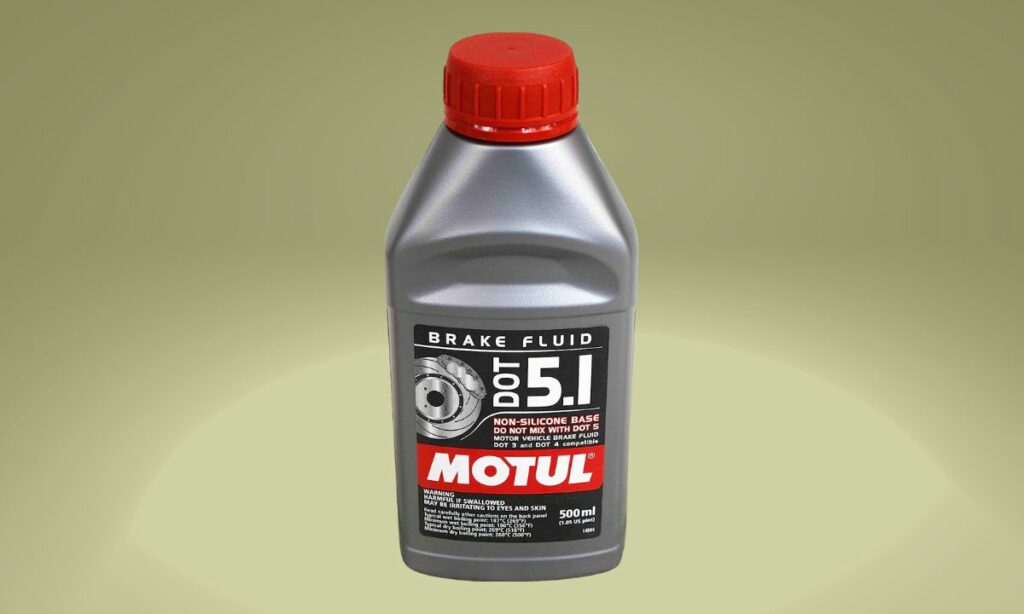
DOT 5.1 is a glycol-based brake fluid. As a result, its properties are closer to DOT 4 than DOT 5.
Then why the name DOT 5.1? Why not 4.1 or 4.5?
The brake fluid nomenclature is dependent on the boiling points.
Since DOT 5.1 boiling point is higher than DOT 5, albeit slightly, it has to be named higher than 5.
Here are DOT 5.1 boiling points:
- DOT 5.1 dry boiling point: 518o F / 270o C
- DOT 5.1 wet boiling point: 374o F / 190o C
Why not DOT 6?
DOT 5.1 boiling points are only slightly higher than DOT 5. They are almost the same.
But since one is silicon-based and the other is glycol-based, these two brake fluids need to be distinguished. Hence the names DOT 5 and DOT 5.1.
Make no mistake. DOT 5.1 is more similar in characteristics to DOT 4 than DOT 5.
Eventually, DOT 5.1 should be popular. But for now, DOT 4 is the preferred brake fluid in most motorcycles since these vehicles are designed for DOT 4.
Pros and Cons
Pros:
- Higher boiling points
- Less hygroscopic than DOT 3 and DOT 4
Cons:
- Expensive
- Low compatibility since most vehicles are designed for DOT 4
Differences
Here are the main differences between DOt 3, DOT 4, DOT 5, and DOT 5.1 summarised in the table format:
| Brake fluid | DOT 3 | DOT 4 | DOT 5 | DOT 5.1 |
|---|---|---|---|---|
| Fluid type | Glycol based | Glycol based | Silicon based | Glycol based |
| Hygroscopic | Yes | Yes | No | Yes |
| Boiling points | Low | Medium | High | High |
| Lifespan | Low | Medium | High | High |
| Cost | Cheap | Affordable | Expensive | Expensive |
| Used in | Outdated, not used much | Motorcycles and other vehicles | Military equipment | Racing vehciles |
Since brake fluids’ boiling points are important, here is the collated boiling points of all the brake fluid types:
| Brake Fluid | Dry Boiling point | Wet Boiling Point |
|---|---|---|
| DOT 3 | 401o F / 205o C | 284o F / 140o C |
| DOT 4 | 446o F / 230o C | 311o F / 155o C |
| DOT 5 | 500o F / 260o C | 356o F / 180o C |
| DOT 5.1 | 518o F / 270o C | 374o F / 190o C |
Do’s and Don’ts of brake fluids
Here are a few thumb rules to follow regarding brake fluids.
- Do not mix brake fluid types. A DOT 5 is strictly not allowed to mix with any other fluids. While DOT 3 and DOT 4 are technically mixable, it is still NOT recommended since they can react badly and corrode the brake system.
- Do NOT use DOT 3 in your motorcycle since its boiling point is too low. The brake system might not work properly with DOT 3.
- Do NOT use DOT 5 in your motorcycle unless it is specifically recommended by the manufacturer. DOT 5 is usually not compatible with most motorcycles.
- Choose the right brake fluid based on the manufacturer’s recommendation from (a) the owner’s manual or (b) as mentioned on the master cylinder cap.
- Change the brake fluid every 2 years. Completely drain the existing fluid and replace with a new one.
FAQs
DOT 5 and DOT 4 should never be mixed together. DOt 4 is glycol-based brake fluid whereas DOT 5 is silicon-based. They are incompatible and can cause problems in the brake system if mixed together.
DOT 5 brake fluid’s compressibility and viscosity are incompatible with motorcycle braking systems. Since most motorcycles are designed for DOT 4, DOT 5 doesn’t work well in these vehicles. Especially if there is ABS.
While technically DOT 3 and DOT 4 can be mixed, it is advised NOT to mix them together. Both are glycol-based and hence are fine technically if mixed. The mixture can react badly and might corrode the surfaces fast.
Before you go…
Here are a few more posts of ours that might pique your interest:
